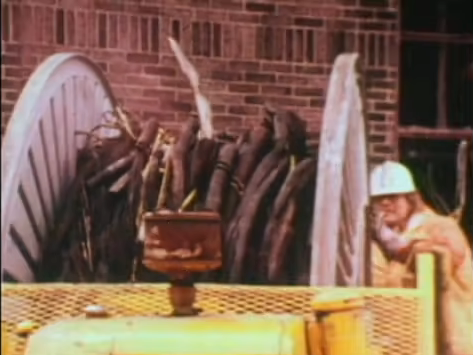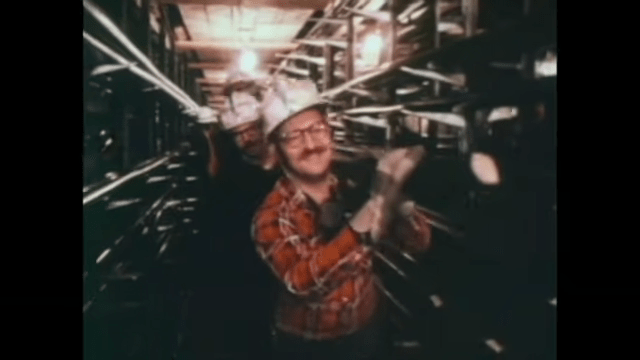Those who haven’t experienced the destruction of a house fire should consider themselves lucky. The speed with which fire can erase a lifetime of work — or a life, for that matter — is stunning. And the disruption a fire causes for survivors, who often escape the blaze with only the clothes on their backs, is almost unfathomable. To face the task of rebuilding a life with just a few smoke-damaged and waterlogged possessions while wearing only pajamas and slippers is a devastating proposition.
As bad as a residential fire may be, though, its impact is mercifully limited to the occupants. Infrastructure fires are another thing entirely; the disruption they cause is often felt far beyond the building or facility involved. The film below documents a perfect example of this: the 1975 New York Telephone Exchange fire, which swept through the company’s central office facility at the corner of 2nd Avenue and 13th Street in Manhattan and cut off service to 300 blocks of the East Village and Lower East Side neighborhoods.
The fire, which started due to a short circuit in one of the basement cable vaults during the graveyard shift on February 27th and spread rapidly up through cable chases into the rest of the building, eventually escalated to five alarms and involved more than 700 FDNY firefighters. It took more than 16 hours to extinguish the blaze, which belched black smoke as miles of PVC-insulated cable burned to cinders.

Before the toxic smoke even cleared, New York Telephone’s rebuilding efforts were underway. Job one was to assess the damage, and the picture was grim: all the switching equipment on the second and third floors of the building was destroyed, smoke and water vapor damaged equipment all the way up the eleven-story building, and most of the 2,400-pair vault cables entering the building’s basement were melted to slag. With over 170,000 customers deprived of their only means of communication, NYTel engineers and managers had to figure out how to restore service as rapidly as possible.
Sensing the historic nature of this disaster — it would remain the most destructive and disruptive event in Bell System history until the 9/11 attacks — AT&T dispatched a film crew to document the recovery. The film may feel a little self-congratulatory, but considering the enormity of the problems they had to overcome, the praise and plaudits are well-deserved. Five thousand employees from all over the Bell System converged on lower Manhattan to strip out the destroyed equipment, clean and repair the building, and begin rebuilding the exchange from scratch. Supplies and gear were diverted from all over the country to aid the effort; in a notably lucky break, a main distribution frame destined for another office was pulled from a Western Electric loading dock, shipped to NYC, and installed in only four days, instead of the six months a job like that would normally take.
Thanks to the massive mobilization, what came to be known as “The Miracle on 2nd Avenue” restored service to all customers in a mere 23 days. That success came at a very high price, though; even though no lives were lost in the fire, over 300 firefighters were injured during the response. But that was only a shadow of things to come — thanks to the toxic smoke from all that burning PVC, over forty cases of cancer cropped up in first responders over the ensuing decades. If you ever wondered why building codes specify “plenum-rated” cables for certain locations, it’s at least partly thanks to the lessons learned from this fire, and the health consequences suffered by those who set it all to rights.
We got wind of this one through an [Anonymous] tip. Thanks!

















I still have my “red card” to be able to work inside ATT exchange facilities. The key parts of the training I remember:
1) Do not drill into walls without x-raying first.
2) Do not x-ray in the facility.
Having said that, I will note that those old-style ATT exchange buildings are SOLID. I would definitely try to hide in one if I were stuck in a major city during a nuclear attack.
nah, they can’t take a nutjob with a bomb in a van (the area is still seriously screwed up) https://en.wikipedia.org/wiki/2020_Nashville_bombing
A friend of mine who works in telecom had to go do a thing to some of his equipment and I got to tag along.
The… I’ll call it “switch building?” was one of those brutalist architecture concrete bunkers left over from when everything weighed tons and tons. It was mostly empty inside with some cabinets of server or switch equipment here and there. But I think you’re right for any natural or man made disaster the only better thing would be a purpose built subterranean concrete blast shelter.
It probably wasn’t “mostly empty” when it was built. A lot of old Bell and AT&T facilities were left hollow shells after the big switching racks were replaced with a computer in the corner of the big room.
Sooo in order to mount something on the wall you need to call Superman. Has X_Ray vision and also lasers in his eyes so he can do both jobs in one.
For all her faults, Ma Bell was a FORCE. Overpriced, entrenched, with technological tunnel vision, she nevertheless delivered. Maybe not exactly what we needed (e.g.: PicturePhone) but the entire country had robust, dependable, dial-up phone service.
Sad to see her go on one hand, amazed at what we got in exchange: essentially free worldwide communication (there’s a lot of Ma Bell DNA in The Internet)
A good documentary! Folks old enough to remember a world without cell phones would understand the urgency. Today, many a Central Office has empty floors and space available as services move to internet, VoIP and cell phones. There is tons more data traffic, but the floor space required is tiny compared to the mechanical telephone systems. Outages to services affecting thousands happen when a fiber trunk cable gets “found” by a backhoe, or someone upgrades a critical router overnight with erroneous path information.
last year I was involved in a rebuild of a small rural exchange. After the exchange fire it was back online within days thanks to temporary satellite receiver and mobile base trailers. There are even temporary enterprise networking trailers available.
” If you ever wondered why building codes specify “plenum-rated” cables for certain locations, it’s at least partly thanks to the lessons learned from this fire, and the health consequences suffered by those who set it all to rights.”
Fire suppression systems in server rooms.
The way the whole AT&T organization got behind the repairs was amazing, really shows just how integrated the Bell System was.
Check out AT&T’s SXS switching cutover to ESS video and see where the term cutover originated.
https://www.youtube.com/watch?v=saRir95iIWk
First of all, my greatest respect for the people’s achievements!
They did a very good job at replacing things so fast.
Secondly, I’m surprised that they didn’t switch to digital technology straight away during the repair.
This was basically there in the 70s. Wouldn’t this have been benefitical, considering the advent of the DMTF landline telephones at the time? This isn’t meant as a critique, whatsoever.
In my country, we still used the old electro-mechanical rotarty switches in the telephone exchange.
But for new systems, the digital technology (microelectronics) was being considered or planned (on paper).
They replaced the damaged equipment with the same type for several good reasons:
1. It was available. They pulled in equipment from all over the US that was scheduled for new installations in other places – there wasn’t time to manufacture new stuff.
2. Installing new, digital equipment would have required completely re-planning all the wiring in the exchange. By putting things back together just as they were, they saved a lot of time that they would have had to spend on designing a new system.
3. Digital exchanges were just becoming a thing in the mid 1970s. It is doubtful that there would have been an exchange just “laying around” that they could ship in and use in 1975.
Reminds me of a Bell fire here; was Canadian HQ and switching; service was pickup up by other Bells on the Eastern Seaboard. Some did not notice, Some of Downtown that switched thru that building was knocked out.
https://www.cbc.ca/news/canada/small-fire-big-headache-for-bell-1.181523
Hmmmm. Robert Redford “hacked” the NYC telephone system in the 1975 film “Three Days of the Condor” by cross-connecting some pairs.
Perhaps he left an uninsulated pair lying across some terminals?
I’m just asking the questions. Was there a cover-up? /jk
It’s a good film, and moderately accurate, technology-wise. And there’s a PDP-8 in it.